![]() Door snails (Clausiliidae):
General information.
Door snails (Clausiliidae):
General information.
![]() Door snails (Clausiliidae):
Systematics of Central European species.
Door snails (Clausiliidae):
Systematics of Central European species.
A note: The author of the present pages is not Hartmut Nordsieck! The sources of picture are always mentioned. Any labelling is by the present author, consequently all resulting errors are also his!
Contents
Subfamily Alopiinae
Plaited door snail (Cochlodina laminata)
Cochlodina orthostoma
Subfamily Clausiliinae
Clausilia rugosa
Clausilia dubia
Ventricose door snail (Macrogastra ventricosa)
Macrogastra attenuata
Macrogastra plicatula
Subfamily Baleinae
Common door snail (Alinda biplicata)
Laciniaria plicata
Grey door snail (Bulgarica cana)
Note:
![]() takes you back to the page start!
takes you back to the page start!
The area with the largest diversity of door snail (Clausiliidae) species may be in south-eastern Europe, such as the Balkan peninsula and especially Greece. But also the native door snail species are likely to scare the layman and even some scientists may be brought at their limits. Some of the native door snail species shall be described here to give an insight into their identification and help in distinguishing them.
As already described in the general part, mainly the following shell characters are used (if an identification by shell characters is possible, otherwise an anatomical examination becomes necessary, which, taking into account the very small size of those snails, should only be done by a specialist):
![]() Hartmut Nordsieck:
Clausiliidae
1: Collecting
and treating door snails, as well as all scientific terms of the clausiliar
necessary for the identification of shells.
Hartmut Nordsieck:
Clausiliidae
1: Collecting
and treating door snails, as well as all scientific terms of the clausiliar
necessary for the identification of shells.
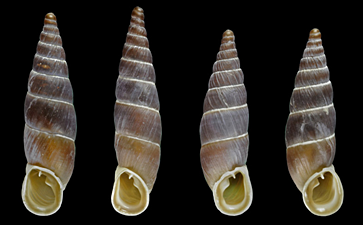 Left Fuchs' Door Snail (Alopia straminicollis) and Right Fuchs' Door Snail (Alopia livida) from the Velikan valley (Bucegi, Romania). Picture: Sigrid Hof (Source: hnords.de). |
Among the Alopiinae there are, as the name already states, door snails of the Alopia genus, mainly found in the Carpathians of the Czech republic and Slovakia as far as Rumania. Among those there are also right-handed species, such as the Right Fuchs' door snail (Alopia livida), which is right-handed, in contrary to the almost mirror image of the Left Fuchs' door snail (Alopia straminicollis), partially sharing its habitat. Among the Alopiinae there is also the genus Albinaria, very rich in forms, of which there are right-handed species, for example in the south of the Peloponnesus peninsula.
![]() Hartmut Nordsieck:
Dextral Clausiliidae (Gastropoda, Stylommatophora), an evolutionary problem.
Hartmut Nordsieck:
Dextral Clausiliidae (Gastropoda, Stylommatophora), an evolutionary problem.
![]() Hartmut Nordsieck:
Interspecific hybridization in the genus Alopia (Gastropoda, Stylommatophora,
Clausiliidae).
Hartmut Nordsieck:
Interspecific hybridization in the genus Alopia (Gastropoda, Stylommatophora,
Clausiliidae).
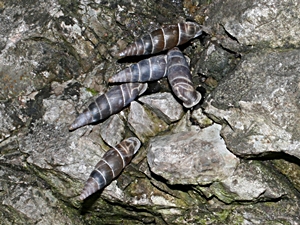
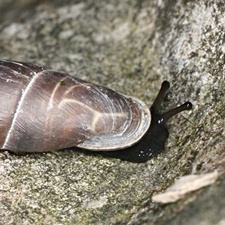 Bosnian door snails (Herilla bosniensis) in the Klausen gorge near Mödling (A). Right: Palatal view. Pictures: © Alexander Mrkvicka, Vienna. |
A part of the Alopiinae subfamily are also native species, such as the Cochlodina genus (see below) and its immediate relatives, as well as an introduced species, the Bosnian Door Snail (Herilla bosniensis), present only in the Klausen gorge near Mödling in Lower Austria.
In the Bosnian door snail, the folds on the palatal side of the aperture are well to be seen as whitish stripes on the outer wall.
In the following genus Cochlodina in Europe four subgenera are distinguished: Cochlodina, Cochlodinastra, Paracochlodina and Procochlodina.
![]() Checklist of European Continental
Mollusca (CLECOM): Genus Cochlodina.
Checklist of European Continental
Mollusca (CLECOM): Genus Cochlodina.
Plaited Door Snail - Cochlodina
(Cochlodina) laminata (Montagu
1803)
![]()
The plaited door snail is among the most common native door snail species. It is relatively easy to recognize, as its shell surface, like its name states, is smooth and not ribbed, like other door snails.
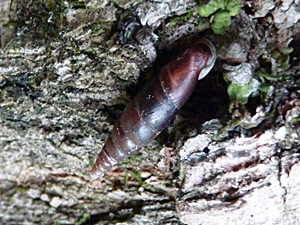 Plaited door snail (Cochlodina laminata) from the Vienna Woods. Picture: Martina Eleveld. |
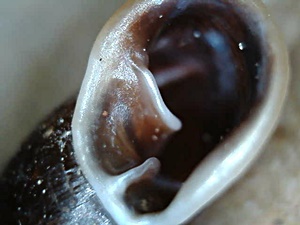 Aperture (periostome) of Cochlodina laminata. Picture: Martina Eleveld. |
Description: The plaited door snail has a rather ventricose shell with
a smooth and shining surface and a yellowish red to reddish brown, sometimes
even cherry-red colour. The parietal lamella is small, the columellar lamella protruding more strongly.
The subcolumellar lamella is visible at an oblique view
into the aperture. The spiral lamella is not ascending as far as the columellar
lamella. Palatal callus weak, but wide
![]() .
.
A distinction from other Cochlodina species (orthostoma and fimbriata) is possible by the form and the relation of the palatal callus and the palatal folds (3: Upper palatal fold; 4: Lower palatal fold; 6: Principal fold).
Additionally, in Cochlodina fimbriata the apertural rim does not connect on the parietal side. In Cochlodina orthostoma (see below) the columellar rim of the aperture is straight, not rounded
Dimensions: H: 15 - 17 mm; W: 4 mm.
![]()
Habitat and Distribution: The plaited door snail lives in deciduous forests on the ground or under bushes, in the leaf litter and between mosses. In the mountains, it is also found in coniferous forests. In humid weather, it climbs on tree trunks. This door snail species feeds on algae, microbial fungi and decaying wood in wet leaf litter.
In Central Europe, the plaited door snail is on of the most common door snail species. It is found in all of Europe, from southern Scandinavia to northern Spain, as far south as southern Italy, the southern Balkan peninsula and the Caucasus. On the British Isles, it is absent in the south of Ireland, in the north of Scotland and the adjacent islands. In the Alps, the species appears in altitudes of up to 2000 m MSL.
![]() Francisco
Welter-Schultes:
Cochlodina laminata species homepage.
Francisco
Welter-Schultes:
Cochlodina laminata species homepage.
Pale Door Snail - Cochlodina
(Cochlodina) fimbriata (Rossmässler
1835)
![]()
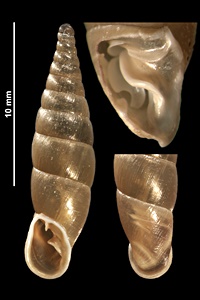 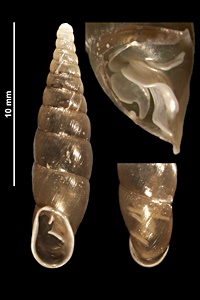 Cochlodina laminata (left) and Cochlodina fimbriata (right) in comparison. Pictures: O. Gargominy (Source, Source). |
Description: The pale door snail resembles the
plaited door snail, but on its shell surface ribs are more distictly
visible. The colour of the shell is usually paler. The Pale Door Snail shows a
strong palatal callus and its lower palatal fold is weak, not reaching the callus.
This is different from Cochlodina laminata, as that species has a weak
palatal callus and a strong lower palatal fold. The apertural rims do not meet
on the basal side
![]() .
.
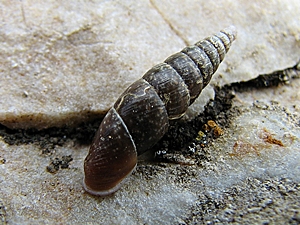 Pale door snail (Cochlodina fimbriata) from Lombardy (Italy). Picture: Gianbattista Nardi (Source). |
Dimensions: H: 14 - 16 mm; W: 3,6 - 4.,4 mm. ![]()
Habitat and Distribution: The Pale Door Snail prefers humid and shady places in deciduous forests (not in coniferous forests) and between calcareous rocks. It is more closely bound to limestone ground, as is Cochlodina laminata. In wet weather, the snail climbs trees to high altitudes, it is also found under the bark und between leaves.
The distribution area of the Pale Door Snail spreads from the Alpine promontories (e.g. the Lake Constance Area in Southern Germany) over the Alps as far south as the Apuan Alps in the northwest of Tuscany, through the Dinaric Mountains as far as Croatia, and in the Carpathian Mountains. In Switzerland the species can be found in atitudes up to 1600 m MSL. In Southern Slovenia, the Pale Door Snail is the most frequent door snail species.
Threat Situation: In Germany, the Pale Door Snail is classified as endangered
(EN), in Vorarlberg it is vulnerable VU and in Austria generally it is
classified with least concern LC) (![]() see: IUCN Threat Categories).
see: IUCN Threat Categories).
![]() Francisco
Welter-Schultes:
Cochlodina fimbriata species homepage.
Francisco
Welter-Schultes:
Cochlodina fimbriata species homepage.
![]() Hartmut
Nordsieck:
Artenreiche Clausilienfaunen in Europa (German).
Hartmut
Nordsieck:
Artenreiche Clausilienfaunen in Europa (German).
Cochlodina (Paracochlodina)
orthostoma (Menke
1828)
![]()
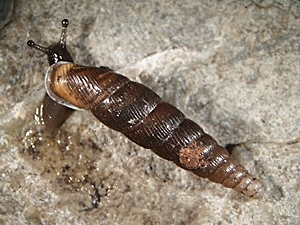 Cochlodina orthostoma from Slovakia. Picture: Jozef Grego (Source). |
Description: As its scientific name already states, this door snail species is different from Cochlodina laminata in having a straight apertural rim, especially in the columellar area.
Additionally, the shell surface is ribbed, and not entirely smooth. The palatal folds are not visible in the aperture (picture). Generally, Cochlodina orthostoma is slightly smaller than Cochlodina laminata.
On the aperture's rear wall, in the neck area of the shell, the palatal
callus is clearly visible as a yellowish red stripe
![]() .
.
Dimensions: H: 12 - 13 mm; W: 3 mm; N: 9½ - 10. ![]()
Habitat and Distribution: Cochlodina orthostoma lives in deciduous forests, in humid and shady places, often on tree trunks. Like Cochlodina laminata it is found irrespective of the type of stone underground.
Cochlodina orthostoma is an ovoviviparous snail species, it gives birth to living young, hatched in the mother's body (see: Alinda biplicata).
The distribution area of this species stretches from Central and East Europe as far as south-western Finland, the Ukraine and the Dobrudsha in Rumania, as well as the North and North-East Alps. In North Germany the species is absent. So it is on the British Isles, where Cochlodina laminata is the only Cochlodina species present in both Ireland and Britain. In Switzerland it is found in altitudes of up to 1400 m MSL.
![]() Francisco
Welter-Schultes:
Cochlodina orthostoma species homepage.
Francisco
Welter-Schultes:
Cochlodina orthostoma species homepage.
Among the subfamily of Clausiliids "in the narrow sense" with Clausilia rugosa there is the nomenclatorial species of all Clausiliidae. The small to medium size door snails at the palatal base of their shell have a ridge accompanied by a groove. Their aperture at the bottom is narrowed in in a groove shape. Upper (parietal) lamella and spiral lamella are connected, the lower palatal fold limits the palatal callus.
Clausilia rugosa (Draparnaud
1801)
![]()
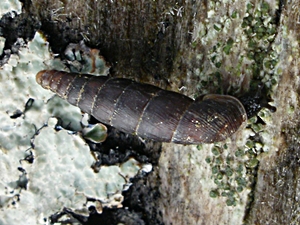 Clausilia rugosa parvula. Picture: © Sigrid Hof (Source). |
Description: Clausilia rugosa is quite variable - their shells can be
brownish to cherry brown, when weathered, also violet. There may be a weak
sculpture of ribs, but the shell surface may also almost be smooth. The ribs
never are striped white. The shell neck shows a distinct keel. The lower
(columellar) lamella lies deep, but is well visible in the shell mouth and in
the front shows a double little fold. The interlamellar shows little folds
![]() .
.
The shell mouth is pear-shaped and yellowish brown, the apertural rim is detached. There are several subspecies to Clausilia rugosa: Clausilia rugosa rugosa is widely ribbed and appears in south-eastern France (Hérault and Gard), Clausilia rugosa reboudii is narrowly ribbed and appears in the south of Frasnce. Clausilia rugosa parvula finally is almost smooth and appears in the north of the species' distribution area. Especially in the older literature, Clausilia rugosa parvula is often mentioned as the small door snail, Clausilia parvula.
Dimensions: H: 7 - 12 mm; W: 1.9 - 2.5 mm; N: 9½ - 10½.
![]()
Habitat and Distribution: Clausilia rugosa loves warmth and can be found in quite humid places between rocks and stones, as well as on old walls. The species is calciphile, but not necessarily restricted to limestone ground.
The species' distribution area stretches from West, South and Central Europe as far east as the northern Carpathians, western Slovakia, south-western Poland, South Italy (Abruzzi mountains), Piedmont and North-East Spain. In Switzerland, Clausilia rugosa climbs to altitudes of up to 2400 m MSL.
![]() Francisco
Welter-Schultes:
Clausilia rugosa species homepage.
Francisco
Welter-Schultes:
Clausilia rugosa species homepage.
Craven Door Snail - Clausilia dubia Draparnaud
1805
![]()
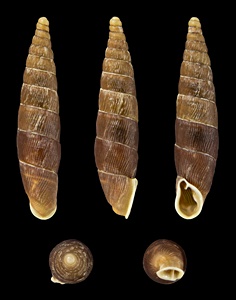 Clausilia dubia: Schalksburg, Württemberg (D). Picture: H. Zell. |
Description: Clausilia dubia usually is narrowly ribbed, but
some populations can also be more widely ribbed. There are no little folds on
the interlamellar, but the lower lamella shows a double little fold. The frontal
lower palatal fold is reduced in some populations. The frontal upper palatal
lamella ends in a callus. The neck keel is more prominent than in the
Macrogastra genus (see below). There are very many local forms
![]() .
.
Dimensions: H: 11 - 14 mm; W: 2.7 - 3.2 mm. ![]()
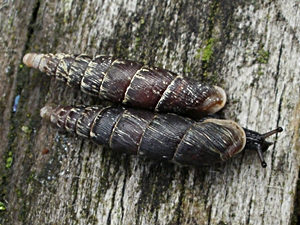 Clausilia dubia. Picture: © Sigrid Hof (Source). |
|
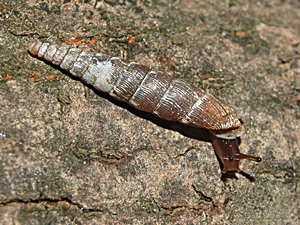 Clausilia bidentata) from Genoa, Italy. Picture: Wikipedia. |
Habitat and Distribution: Clausilia dubia usually lives on humid and shady rocks and old walls, as well as on tree trunks full of moss. It only rarely is found in the plains, but more often in the highlands. Clausilia dubia, too, is a calciphile species. During periods of dryness, it hides in crevices and in the ground litter, to crawl up trees during wet weather. Clausilia dubia also feeds on lichens and algae.
The distribution area of the species covers all of Europe, except the Mediterranean peninsulas. On the British Isles there are two subspecies, C. dubia dubia and C. dubia suttoni, in isolated populations in North England, usually between 250 an 600 m MSL, and introduced near Dover, also the species is present isolated in Finland and Sweden. In Switzerland, Clausilia dubia can be encountered in altitudes of up to 2400 m MSL.
Several widely ribbed populations, whose isolated distributions constitute separate subspecies, have been found in Carinthia, Styria, Lower Austria Slovakia and Transylvania (see also: Wolfgang Fischer: Clausilia dubia). However, the distinction of subspecies is hard to recapitulate morphologically (H. Nordsieck 2002), as well as genetically (Jaksch, 2012, lecture), and therefore remains disputed.
Threat Situation: In North England, the species is threatened by air pollution and the destruction of habitats. In Germany it has been classified as vulnerable (VU) (see also: IUCN Threat Categories). In Switzerland, Clausilia dubia is rare in low altitudes.
![]() Francisco
Welter-Schultes:
Clausilia dubia species homepage.
Francisco
Welter-Schultes:
Clausilia dubia species homepage.
![]() Katharina Jaksch: Working group "Alpine Land Snails"
of the Vienna Natural History Museum:
Clausilia dubia project (Accessed 18.06.2012).
Katharina Jaksch: Working group "Alpine Land Snails"
of the Vienna Natural History Museum:
Clausilia dubia project (Accessed 18.06.2012).
![]() Edlinger,
K., Fischer, W. (2000): Zur Variabilität von Clausilia dubia (Draparnaud
1805) in Mitteleuropa. Nachrichtenblatt d. E. Vorarlb. Mal. Ges., 8, 1 - 14.
Edlinger,
K., Fischer, W. (2000): Zur Variabilität von Clausilia dubia (Draparnaud
1805) in Mitteleuropa. Nachrichtenblatt d. E. Vorarlb. Mal. Ges., 8, 1 - 14.
![]() Frank,
C. (1997): Studien an Clausilia dubia Draparnaud 1805 (Stylommatophora:
Clausiliidae). - Wiss. Mitt. Niederösterr. Landesmuseum, 10, 163 - 189.
Frank,
C. (1997): Studien an Clausilia dubia Draparnaud 1805 (Stylommatophora:
Clausiliidae). - Wiss. Mitt. Niederösterr. Landesmuseum, 10, 163 - 189.
![]() Klemm, W.
(1960): Clausilia dubia Draparnaud und ihre Formen in österreich. - Arch. Moll.,
89(1/3): 81-109; Frankfurt/Main.
Klemm, W.
(1960): Clausilia dubia Draparnaud und ihre Formen in österreich. - Arch. Moll.,
89(1/3): 81-109; Frankfurt/Main.
![]() Nordsieck, H.
(2002): "The subspecies classification of Clausilia dubia Draparnaud (Gastropoda:
Stylommatophora: Clausiliidae), a critical revision". - Mitt. Dt. Mal. Ges. 68:
37-44; Frankfurt/Main.
Nordsieck, H.
(2002): "The subspecies classification of Clausilia dubia Draparnaud (Gastropoda:
Stylommatophora: Clausiliidae), a critical revision". - Mitt. Dt. Mal. Ges. 68:
37-44; Frankfurt/Main.
Ventricose Door Snail - Macrogastra ventricosa (Draparnaud
1801)
![]()
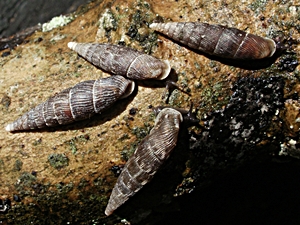 Macrogastra ventricosa on the left, Alinda biplicata (below), and M. attenuata (above). Picture: © Sigrid Hof (Source). |
Description: The ventricose door snail is the largest native door
snail species. Its shell surface is widely ribbed, at the suture between whorls,
the ribs in groups are striated white. The apertural whorl's neck at the front
displays a keel. The aperture rim is detached. On the interlamellar there are no
little folds. The lower (columellar) lamella shows a double fold at its front,
so it looks like a lying K (![]() ). Macrogastra ventricosa
shows no palatal folds or calluses. It may be distinguished from the common door
snail (Alinda biplicata) by the missing basal groove. The aperture's
interior is light brown
). Macrogastra ventricosa
shows no palatal folds or calluses. It may be distinguished from the common door
snail (Alinda biplicata) by the missing basal groove. The aperture's
interior is light brown
![]() .
.
Dimensions: H: 17 - 19 mm; W: 3.8 - 4.4 mm. ![]()
Habitat and Distribution: The ventricose door snail lives in humid forests, especially in the mountains, in the ground litter, in places grown with mosses, like rocks and tree stems. In Schleswig-Holstein the ventricose door snail also lives in alluvial forests and on steep slopes near springs. In wet weather, it also crawl up tree stems and rocks.
The species' distribution are covers Europe from South Norway and Central Russia as far south as North Spain and North Italy. In Switzerland, Macrogastra ventricosa appears in altitudes of up to 1800 m MSL.
In the largest part of the North German lowlands the ventricose door snail is only found in a disperse manner. There are populations, though, in Schleswig-Holstein (only locally and rare), in Mecklenburg, as well as in West and East Prussia (Poland and Russia). Isolated populations of the ventricose door snail also can be found in the south of Finland.
![]() Vollrath Wiese et al.:
Verbreitungsatlas Schleswig-Holstein 1991:
Macrogastra ventricosa - Bauchige Schließmundschnecke. (In German)
Vollrath Wiese et al.:
Verbreitungsatlas Schleswig-Holstein 1991:
Macrogastra ventricosa - Bauchige Schließmundschnecke. (In German)
![]() Francisco Welter-Schultes:
Macrogastra ventricosa species homepage.
Francisco Welter-Schultes:
Macrogastra ventricosa species homepage.
Macrogastra attenuata (Rossmässler
1835)
![]()
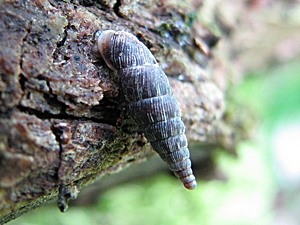 Macrogastra attenuata from Lombardy, Italy. Picture: © Gianbattista Nardi (Source). |
Description: The reddish brown shell of Macrogastra attenuata
is slightly smaller than that of Macrogastra ventricosa and richly
striated in white. Like its lager relative, it also shows the forked, K-shaped
lower (columellar) lamella. On the interlamellar there are one or two weak
little folds. At the lower side, the aperture is distinctly rounded, A palatal
callus is often visible as an unclear whitish line. The subcolumellar lamella is
visible when looking straight into the aperture. The number of ribs on the
apertural whorl is between 60 and 65
![]() .
.
Dimensions: H: 11 - 14 mm; W: 2,8 - 3,2 mm. ![]()
Habitat and Distribution: Macrogastra attenuata is an inhabitant of humid mountain forests, where it lives in the leaf litter, on rocks and stones, as well as between rocks grown with mosses. The species also inhabits places no matter on which stone ground. In Schleswig-Holstein, Macrogastra attenuata also lives in spring areas and in alluvial forests. During wet weather, Macrogastra attenuata does not climb the tree trunks, but remains in the leaf litter and generally stays more on the ground.
The species' distribution area covers Europe from Denmark until Italy and North-West Spain.
Threat Situation: In Lower Saxony Macrogastra attenuata is classified as vulnerable (VU) (see also: IUCN Threat Categories).
Systematics: In literature, the species is either mentioned as Macrogastra attenuata, partly as Macrogastra lineolata and partly as Macrogastra attenuata lineolata. H. Nordsieck (1993) therefore suggests to refer to the species as such as Macrogastra attenuata and to use Macrogastra attenuata lineolata for the northern subspecies.
![]() Nordsieck,
H. (1993): Beiträge zur Nomenklatur der europäischen Binnenmollusken, I.
Kritische Anmerkungen und Berichtigungen zur Nomenklatur der Clausiliidae. -
Heldia 2 (3/4): 33 - 42. (In German)
Nordsieck,
H. (1993): Beiträge zur Nomenklatur der europäischen Binnenmollusken, I.
Kritische Anmerkungen und Berichtigungen zur Nomenklatur der Clausiliidae. -
Heldia 2 (3/4): 33 - 42. (In German)![]() Vollrath Wiese et al.:
Verbreitungsatlas Schleswig-Holstein 1991:
Macrogastra attenuata lineolata - Mittlere Schließmundschnecke. (In German)
Vollrath Wiese et al.:
Verbreitungsatlas Schleswig-Holstein 1991:
Macrogastra attenuata lineolata - Mittlere Schließmundschnecke. (In German)
![]() Francisco Welter-Schultes:
Macrogastra attenuata species homepage.
Francisco Welter-Schultes:
Macrogastra attenuata species homepage.
Macrogastra plicatula (Draparnaud
1801)
![]()
Description: Macrogastra plicatula has a reddish brown shell, slightly striated white. The shell is smaller and more slender as that of Macrogastra attenuata. The aperture is elliptic to oval. The basal keel is less prominent, as in the Clausilia genus. The interlamellar shows 2 - 3 distinct little folds. The number of prominent ribs on the shell surface on the apertural whorl amounts to 45 - 50. In the spaces between the ribs, a fine spiral striation is visible.
Dimensions: H: 11 - 14 mm; W: 2.8 - 3.2 mm.
![]()
Habitat and Distribution: Macrogastra plicatula lives in deciduous and coniferous forests, in humid places on rocks and tree trunks, outside of forests it also is found on rocks and walls. The species prefers, in contrary to the two previously mentioned species, limestone ground. In Schleswig-Holstein, the species mainly is found on steep slopes near springs, as well as in alluvial forests.
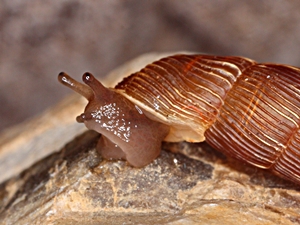 Common door snail (Alinda biplicata). Picture: © Alexander Mrkvicka, Vienna. |
Macrogastra plicatula can be found in all of Europe, in the north as far as southern Scandinavia, Finland and Central Russia. Isolated populations there are in the southern Carpathians and on the Crimean peninsula. In Switzerland, Macrogastra plicatula appears in altitudes of up to 2300 m MSL. In Schleswig-Holstein, the species is only found rarely and sporadically, mainly present near the coast.
![]() Vollrath Wiese et al.:
Verbreitungsatlas Schleswig-Holstein 1991:
Macrogastra plicatula - Gefältelte Schließmundschnecke. (In German)
Vollrath Wiese et al.:
Verbreitungsatlas Schleswig-Holstein 1991:
Macrogastra plicatula - Gefältelte Schließmundschnecke. (In German)
![]() Francisco Welter-Schultes:
Macrogastra plicatula species homepage.
Francisco Welter-Schultes:
Macrogastra plicatula species homepage.
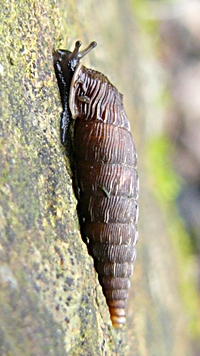 Laciniaria plicata is also a part of the Ba- leinae. Picture: Michal Maňas. |
A member of the Baleinae with the common door snail (Alinda biplicata) probably is the commonest native door snail species.
![]() Common door snail (Alinda biplicata) (on
the general page).
Common door snail (Alinda biplicata) (on
the general page).
Laciniaria plicata (Draparnaud
1801)
![]()
Description: The shell of Laciniaria plicata is brownish and has a
slender spindle form. The parietal side of the aperture is pulled into a
distinct groove. The central palatal fold is almost parallel to the principal
fold. The moon fold (lunella) is strongly elongated and parallel to the shell
axis. The lower (columellar) lamella is little protruding and almost cut off.
The apertural rim displays 7 - 10 more or less distinct folds. There is, though,
a variety without those folds, Laciniaria plicata f. implicata Bielz.
![]() .
.
Dimensions: H: 15 - 18 mm; W: 3.3 - 3.6 mm. ![]()
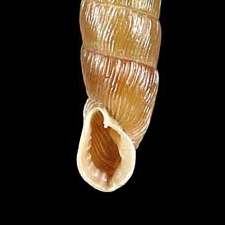 Laciniaria plicata. Picture: Guido Poppe. |
Habitat and Distribution: Laciniaria plicata lives on humid rocks and old walls in open habitats. It is not restricted to calciferous ground, but appears more likely in the highlands than in the plains.
The distribution area of Laciniaria plicata covers Central, East and South-East Europe, from Denmark to the south of the Baltic states, Central Russia, the Ukrainian Carpathians, Bulgaria, Piedmont, the southern Central Alps and East France. In Switzerland the altitude limit of Laciniaria plicata is near 2300 m MSL, but the species becomes rare above 1200 m MSL.
In the North, Laciniaria plicata appears only in a disperse manner, for example in Denmark on Bornholm Island (where it is more common) and in southern Sweden. In Schleswig-Holstein the species is assumed to be lost or extinct, because reports present are already very old and could not be verified.
![]() Vollrath Wiese et al.:
Verbreitungsatlas Schleswig-Holstein 1991:
Laciniaria plicata - Faltenrandige Schließmundschnecke. (In German)
Vollrath Wiese et al.:
Verbreitungsatlas Schleswig-Holstein 1991:
Laciniaria plicata - Faltenrandige Schließmundschnecke. (In German)
![]() Francisco Welter-Schultes:
Laciniaria plicata species homepage.
Francisco Welter-Schultes:
Laciniaria plicata species homepage.
Grey Door Snail - Bulgarica cana (Held
1836)
![]()
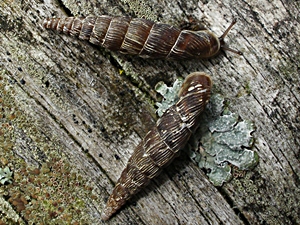 Grey door snails (Bulgarica cana). Picture: © Sigrid Hof (Source). |
Description: The shell of the grey door snail is brownish with a thick
wall and a ribbed surface. The apertural whorl shows a neck keel. The aperture
is quite large (about a fifth of the shell height). There is a weak palatal
callus. The lower (columellar) lamella is strong and usually brownishly coloured.
The moon fold (lunella) is clearly visible. Only the lower palatal fold is
present in front of the lunella, but only as a weakly display basal lamella. The
clausilium
plate is narrow, not bent at the lower end
![]() .
.
Dimensions: H: 16 - 19 mm; W: 3.3 - 4 mm; N: 11 - 14.
![]()
Habitat and Distribution: Bulgarica cana lives on tree trunks in moderately humid deciduous and mixed forests, also on less calciferous grounds. In the Rumanian and Ukrainian Carpathians it is only present in the submontane and lower forest zones up to an altitude of 1300 m MSL. The grey door snail does not leave the tree trunks during dry weather, like other door snails do, but hides in crevices in the bark and under lichens. So it can be found in hornbeam forests on slopes of the Swabian Alb, where it can be observed on fallen logs, in the leaf litter and sitting on tree trunks.
The distribution area of the grey door snail stretches from Central and East Europe to southern Finland (only in the Koli national park area), in the south as far as northern Switzerland, the southern Carpathians and Central Russia in the east.
Threat Situation: In Austria, the grey door snail is critically endangered (CR), in Germany it is classified as endangered (EN), in Switzerland as vulnerable (VU) (see also: IUCN Threat Categories). In Baden-Württemberg it is a so-called state species, which is thought to be a "species especially worthy of natural protection".
![]() Francisco Welter-Schultes:
Bulgarica cana species homepage.
Francisco Welter-Schultes:
Bulgarica cana species homepage.
![]() Jürgen Trautner, Arbeitsgruppe für
Tierökologie und Planung:
Graue Schließmundschnecke (Bulgarica cana). (In German)
Jürgen Trautner, Arbeitsgruppe für
Tierökologie und Planung:
Graue Schließmundschnecke (Bulgarica cana). (In German)

The
Homepage by Hartmut Nordsieck on Helicoidea, Cochlostoma and Clausiliidae on
hnords.de.